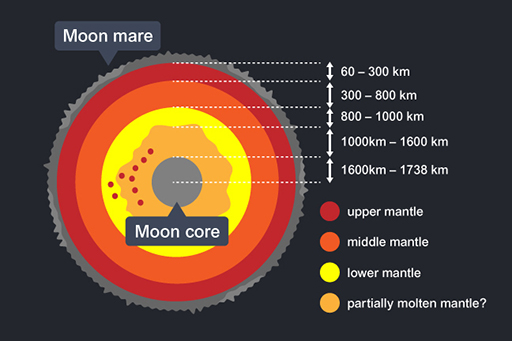1.4 Inside the Moon
Experiments performed by Apollo astronauts on the Moon have shown that its internal structure is similar to that of the Earth. It has a crust, a mantle and a core but, unlike the Earth, has no magnetic field. This is because the Moon’s core is now solid (even an iron core cannot create a magnetic field if it is solid, it has to be molten and churning around so that it acts like a dynamo). The Earth’s crust is also very different because it is made up of plates that slowly form at mid-ocean ridges and collide to produce mountain chains, changing the crust at the surface of the Earth. The atmosphere and climate combined with plate tectonics lead to erosion of mountains, thus destroying evidence of meteorite impacts. The geological features seen on the Moon, however, are different because the crust does not move: there is no plate tectonics.
If you look at the Moon with the naked eye you can see pale highlands and some of the larger craters, as well as dark areas that are by convention called seas or maria (plural of mare). The lunar highlands are the Moon’s original crust, which has suffered many billions of years of bombardment, as explained in Week 2. The darker mare areas are large craters that later filled with extensive lava flows.

It used to be thought that the Moon lost its magnetic field about 3 billion years ago. However a new study of a Moon-rock dated at 1-2.5 billion years old shows that it formed in the presence of a magnetic field, suggesting that the Moon's core remained molten for up to 2 billion years longer than previously assumed. When did the Moon's core become solid? [Tip: hold Ctrl and click a link to open it in a new tab. (Hide tip)] .
